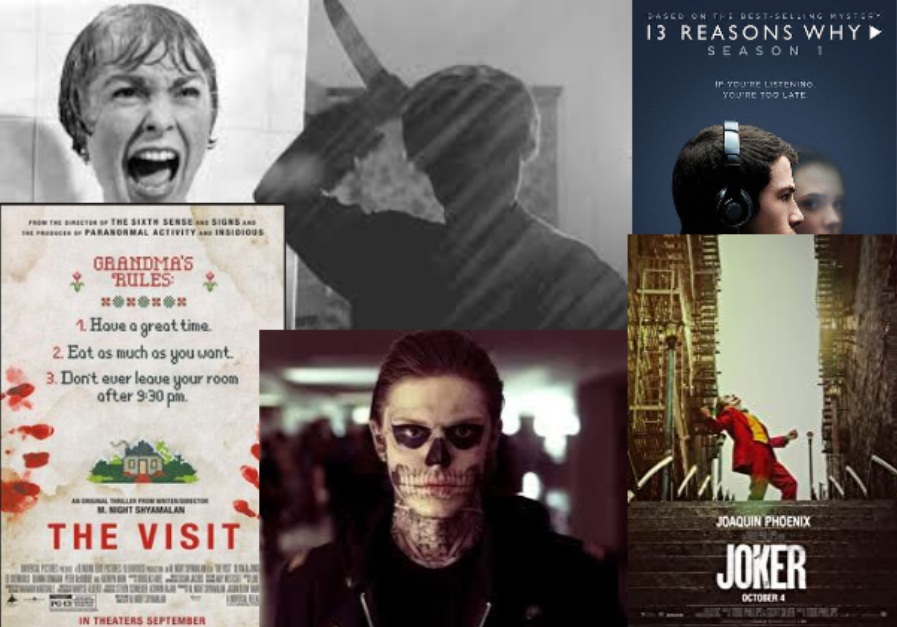
By Samson Le and Kayla Hoang
For most of us, information that we receive is from what we see online, on television or through print, where we may automatically assume it to be true. In plenty of media forms, there exist platforms to influence and raise awareness on mental health today, but can also be harmful and stigmatizes the perception of mental illnesses.
The film industry, one of the largest sources of entertainment we turn to, has a tendency to misrepresent or undermine certain illnesses to glorify them as something they’re not. Madness is something we see romanticized in plenty of popular movies, especially in thriller or horror movies.
The Alfred Hitchcock classic “Psycho,” for example, is a movie that started the trend of later slasher films involving violent murderers under the guise of mental disorders, such as the “Halloween” franchise or “Silence of the Lambs.”
According to a psychiatrist towards the end of “Psycho,” the serial killer protagonist Norman Bates committed murders because he suffered from dissociative identity disorder. The movie introduced the common use of the word “psycho” when describing someone with a mental disorder, which contributed to the stigma of mental illnesses.
Viewers see more modern versions of this trope of madness and insanity being the basis for violence today.
The 2015 horror-thriller “The Visit” depicted a pair of siblings being trapped inside a house of escaped asylum patients, working entirely under the premise of mental illness as nothing but a scare tactic for viewers.
More recently, the 2019 blockbuster “Joker” received controversy for its portrayal of psychosis and its association of mental illness with force and murder, and it further pushes the popular misconception of mental health deterioration leading to violence.
In addition to cinema, television stigmatizes mental health, particularly in its glorification of mental illnesses including depression and anxiety. These mental disorders are often misrepresented, which is harmful considering so many of these shows are aimed at younger and more impressionable audiences.
Tate Langdon, one of the most notable characters of the TV series “American Horror Story” (AHS), is portrayed as a sociopath, but the mistake of the first season of AHS was depicting the condition as something poetic and tragically beautiful for aesthetic purposes, going as far as having Langdon shoot up a school in skull makeup and slicked-back hair.
AHS’s depiction of mental illnesses make them into something enchanting and convinces viewers, especially young ones, that there’s some kind of misunderstood beauty in being toxic and damaged. The show continues to have a following of young teenagers obsessed with Langdon on social media years after the first season ended.
Another one of the most referenced examples of a show romanticizing mental illness is the highly controversial Netflix original “13 Reasons Why” about a young girl who sent out cassette tapes after committing suicide and blaming people for why she took her life.
The show dramatizes suicide and depression, focusing on blaming others instead of providing resources, including counselors and parents, to help. It tells a large teenage audience that suicide is the only way to escape pain, and turns a serious situation as a source of entertainment. The show’s popularity also resulted in an increase in self-harm and suicide rates in teenagers after its release.
Mental illness is something many people experience and is increasingly apparent in our youth today. How these illnesses are represented in the media affects our generation’s understanding of it and, if not done right, makes it more difficult for people to reach out for help.
Mental health isn’t as simple or one-dimensional as the media tend to portray it as. It’s not something that can be easily fixed or suddenly disappear, and although 21st-century media is steadily becoming more open-minded and realistic in its portrayal and understanding of mental health, there’s still stigma surrounding mental disorders.
These stigmas and stereotypes serve to harm and diminish the struggles and lives of real people suffering from mental illnesses and butcher the public’s understanding of what they look like, which is why it’s important to start a bigger conversation about mental health in our society and communities today.
Entertainment media that choose to portray mental illness or conditions should take more effort into understanding what they are depicting to a potentially impressionable audience, including consulting with professionals and those who have experienced a mental disorder, or use their platforms to spread accurate information when discussing mental health.
Outside of the media, there are other resources we can turn to, such as school psychologists and the National Alliance on Mental Illness. Since so many of the target audiences for TV shows and movies are young people, schools also can take bigger steps in incorporating resources, counseling and mental health education for students.
Instead of depending solely on our TV shows and movies as our representation of what mental illness is supposed to look like, we need to take conscious action in communicating about mental health and learning how to support those who need help.
For other mental health resources, contact FVHS counseling and student support staff, or check out the “Wellness” page under Students & Families on the district website at hbuhsd.edu to find mental health tips, newsletters and opportunities to request counseling.





